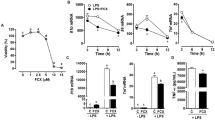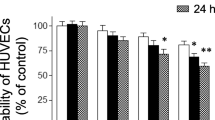Abstract
Objective
α-Lipoic acid (LA) exerts beneficial effects in cardiovascular diseases though its antioxidant and/or anti-inflammatory functions. It is postulated that the anti-inflammatory function of LA results from its antioxidant function. In this study we tested whether inhibition of NF-κB by LA is dependent on its antioxidant function.
Methods
Human umbilical vein endothelial cells (HUVECs) were treated with tumor necrosis factor-α (TNFα) in the presence of various antioxidants, including LA, tiron, apocynin, and tempol. The activation of the nuclear factor-κB (NF-κB) signaling pathway was then analyzed.
Results
LA, but not other tested antioxidants, inhibited TNFα-induced inhibitor-kappaB-α (IκBα) degradation and VCAM-1 and COX2 expression in HUVECs. Although LA activated the phosphatidylinositol-3-kinase (PI3-kinase)/Akt pathway in HUVECs, inhibition of Akt by LY294002 did not affect inhibition of TNFα-induced IκBα degradation by LA. In transient co-transfection assays of a constitutively active mutant of IκB kinase-2 (IKK2), IKK2(EE), and a NF-κB luciferase reporter construct, LA dose-dependently inhibited IKK2(EE)-induced NF-κB activation in addition to inhibiting IKK activity in in vitro assays. Consistent with the effect on luciferase expression, LA inhibited IKK2(EE)-induced cyclo-oxygenase-2 (COX2) expression, suggesting that IKK2 inhibition by LA may be a relevant mechanism that explains its anti-inflammatory effects.
Conclusions
LA inhibits NF-κB activation through antioxidant-independent and probably IKK-dependent mechanisms.




Similar content being viewed by others
References
Smith AR, et al. Lipoic acid as a potential therapy for chronic diseases associated with oxidative stress. Curr Med Chem. 2004;11(9):1135–46.
Louhelainen M, et al. Lipoic acid supplementation prevents cyclosporine-induced hypertension and nephrotoxicity in spontaneously hypertensive rats. J Hypertens. 2006;24(5):947–56.
Thirunavukkarasu V, Anitha Nandhini AT, Anuradha CV. Lipoic acid attenuates hypertension and improves insulin sensitivity, kallikrein activity and nitrite levels in high fructose-fed rats. J Comp Physiol. 2004;174(8):587–92.
Vasdev S, et al. Salt-induced hypertension in WKY rats: prevention by alpha-lipoic acid supplementation. Mol Cell Biochem. 2003;254(1–2):319–26.
Zhang WJ, et al. Dietary alpha-lipoic acid supplementation inhibits atherosclerotic lesion development in apolipoprotein E-deficient and apolipoprotein E/low-density lipoprotein receptor-deficient mice. Circulation. 2008;117(3):421–8.
Zulkhairi A. et al. Alpha lipoic acid possess dual antioxidant and lipid lowering properties in atherosclerotic-induced New Zealand white rabbit. Biomed Pharmacother. 2008;62(10):716–22.
Kamenova P. Improvement of insulin sensitivity in patients with type 2 diabetes mellitus after oral administration of alpha-lipoic acid. Hormones (Athens). 2006;5(4):251–8.
Yang RL, et al. Lipoic acid prevents high-fat diet-induced dyslipidemia and oxidative stress: a microarray analysis. Nutrition. 2008;24(6):582–8.
Milgram NW, et al. Acetyl-l-carnitine and alpha-lipoic acid supplementation of aged beagle dogs improves learning in two landmark discrimination tests. FASEB J. 2007;21(13):3756–62.
Schreck R, Rieber P, Baeuerle PA. Reactive oxygen intermediates as apparently widely used messengers in the activation of the NF-kappa B transcription factor and HIV-1. EMBO J. 1991;10(8):2247–58.
Hayakawa M, et al. Evidence that reactive oxygen species do not mediate NF-kappaB activation. EMBO J. 2003;22(13):3356–66.
Zhang WJ, et al. Alpha-lipoic acid attenuates LPS-induced inflammatory responses by activating the phosphoinositide 3-kinase/Akt signaling pathway. Proc Natl Acad Sci USA. 2007;104(10):4077–82.
Zhang WJ, Frei B. Alpha-lipoic acid inhibits TNF-alpha-induced NF-kappaB activation and adhesion molecule expression in human aortic endothelial cells. FASEB J. 2001;15(13):2423–32.
Marone R, et al. Targeting phosphoinositide 3-kinase: moving towards therapy. Biochim Biophys Acta. 2008;1784(1):159–85.
Gustin JA, et al. Cell type-specific expression of the IkappaB kinases determines the significance of phosphatidylinositol 3-kinase/Akt signaling to NF-kappa B activation. J Biol Chem. 2004;279(3):1615–20.
Acknowledgments
This study was supported by grants from National Institutes of Health (NIH) R01ES013406 and R01ES015146 to Dr. Rajagopalan.
Author information
Authors and Affiliations
Corresponding author
Additional information
Responsible Editor: Liwu Li.
Rights and permissions
About this article
Cite this article
Ying, Z., Kampfrath, T., Sun, Q. et al. Evidence that α-lipoic acid inhibits NF-κB activation independent of its antioxidant function. Inflamm. Res. 60, 219–225 (2011). https://doi.org/10.1007/s00011-010-0256-7
Received:
Revised:
Accepted:
Published:
Issue Date:
DOI: https://doi.org/10.1007/s00011-010-0256-7




